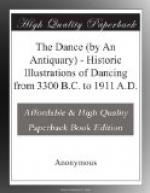A great dance of a severe kind was executed by the Salii, priests of Mars, an ecclesiastical corporation of twelve chosen patricians. In their procession and dance, on March 1, and succeeding days, carrying the Ancilia, they sang songs and hymns, and afterwards retired to a great banquet in the Temple of Mars. That the practice was originally Etruscan may be gathered from the circumstance that on a gem showing the armed priests carrying the shields there are Etruscan letters. There were also an order of female Salii. Another military dance was the Saltatio bellicrepa, said to have been instituted by Romulus in commemoration of the Rape of the Sabines. The Pyrrhic dance (fig. 13) was also introduced into Rome by Julius Caesar, and was danced by the children of the leading men of Asia and Bithynia.
As, however, the State increased in power by conquest, it absorbed with other countries other habits, and the art degenerated often, like that of Greece and Etruria, into a vehicle for orgies, when they brought to Rome with their Asiatic captives even more licentious practices and dances.
[Illustration: Fig. 25.—Funeral dance from the same tomb.]
As Rome, which never rose to the intellectual and imaginative state of Greece in her best period, represented wealth, commerce, and conquest, in a greater degree, so were her arts, and with these the lyric. In her best state her nobles danced, Appius Claudius excelled, and Sallust tells us that Sempronia “psaltere saltare elegantius”; so that in those days ladies played and danced, but no Roman citizen danced except in the religious dances. They carried mimetic dances to a very perfect character in the time of Augustus under the term of Musica muta. After the second Punic war, as Greek habits made their way into Italy, it became a fashion for the young to learn to dance. The education in dancing and gesture were important in the actor, as masks prevented any display of feature. The position of the actor was never recognized professionally, and was considered infamia. But the change came, which caused Cicero to say “no one danced when sober.” Eventually the performers of lower class occupied the dancing platform, and Herculaneum and Pompeii have shown us the results.
[Illustration: Fig. 26.—Bacchante leading the Dionysian bull to the altar. Bas-relief in the Vatican.]
In the theatre the method of the Roman chorus differed from that of the Greeks. In the latter the orchestra or place for the dancing and chorus was about 12 ft. below the stage, with steps to ascend when these were required; in the former the chorus was not used in comedy, and having no orchestra was in tragedies placed upon the stage. The getting together of the chorus was a public service, or liturgia, and in the early days of Grecian prosperity was provided by the choregus.
Tiberius by a decree abolished the Saturnalia, and exiled the dancing teachers, but the many acts of the Senate to secure a better standard were useless against the foreign inhabitants of the Empire accustomed to sensuality and licence.




